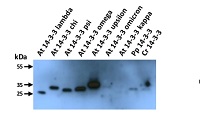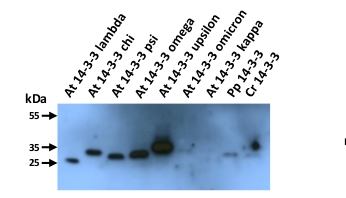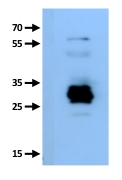1

Anti-14-3-3 GRF | General regulatory element
AS12 2119 | Clonality: Polyclonal | Host: Rabbit | Reactivity: A. platanoides, A. thaliana, C.australis R.Br., L. longiflorum. M. crystallinum, N. tabacum, O. sativa, P. kurroa, P. vulgaris, algae N. oloabundans, Z.mays
- Product Info
-
Immunogen: Conserved surface-exposed peptide conjugated to KLH.This sequence is repeated in all 12 “canonical” members of the Arabidopsis thaliana GRF/14-3-3 family. GRF1 GF14 chi UniProt: F4JJ94, TAIR: AT4G09000, GRF2 GF14 omega, UniProt: Q01525, TAIR: AT1G78300, GRF3 GF14 psi UniProt: F4KBI7, TAIR: AT5G38480, GRF4 GF14 phi UniProt: F4HWQ5, TAIR: AT1G35160, GRF5 GF14 upsilon UniProt: P42645, TAIR: AT5G16050, GRF6 GF14 lambda UniProt: P48349#P48349-2, TAIR: AT5G10450, GRF7 GF14 nu UniProt: Q96300, TAIR: AT3G02520, GRF8 GF14 kappa UniProt: F4KHY7, TAIR: AT5G65430, GRF9 GF14 mu UniProt: F4IP55, TAIR:AT2G42590, GRF10 GF14 epsilon UniProt: F4I1C1, TAIR:AT1G22300, GRF11 GF14 omicron UniProt: Q9S9Z8, TAIR: AT1G34760, GRF12 GF14 iota UniProt: Q9C5W6 TAIR: AT1G26480.Host: Rabbit Clonality: Polyclonal Purity: Serum Format: Lyophilized Quantity: 50 µl Reconstitution: For reconstitution add 50 µl of sterile water Storage: Store lyophilized/reconstituted at -20°C; once reconstituted make aliquots to avoid repeated freeze-thaw cycles. Please remember to spin the tubes briefly prior to opening them to avoid any losses that might occur from material adhering to the cap or sides of the tube. Tested applications: Immunoprecipitation (IP), Western Blot (WB) Recommended dilution: 1: 2000 (WB) Expected | apparent MW: 20-28 kDa (depending upon an isoform)
- Reactivity
-
Confirmed reactivity: Aesculus hippocastanum, Arabidopsis halleri, Arabidopsis thaliana, Lilium longiflorum, Mesembryanthemum crystallinum, Neochloris oloabundans (algae), Oryza sativa, Picrorhiza kurroa, Phaseolus vulgaris, Panax notoginseng, Zea mays, Vicia faba
Predicted reactivity: Brassica sp., Chlamydomonas reinhardtii, Glycine max, Gossypium hirsutum, Nicotiana tabacum, Physcomitrium patens, Pisum sativum, Solanum tuberosum, Triticum aestivum
Species of your interest not listed? Contact usNot reactive in: This antibody does not bind to 14-3-3-like protein D of Nicotiana tabacum.
- Application Examples
-
Application example


Left panel: 150 ng of recombinant Arabidopsis thaliana, Physcomitrella patens and Chlamydomonas reinhardtii GRFs (see more details below) were separated on 12 % SDS-PAGE and blotted 1h to PVDF by semi dry blotting (0.8 mA/cm2 for 60 min). Blots were blocked with 2% skimmed milk powder dissolved in TBST (0.1 % Tween 20) for 1h at room temperature (RT) with agitation. Blot was incubated in the primary antibody at a dilution of 1: 1 000 in blocking solution and incubated for 1h at RT with agitation. The antibody solution was decanted and the blot was rinsed briefly twice, then washed once for 15 min and 3 times for 5 min in TBS-T at RT with agitation. Blot was incubated in secondary antibody (anti-rabbit IgG horse radish peroxidase conjugated, from Agrisera AS09 602) diluted to 1:20 000 in for 1h at RT with agitation. The blot was washed as above and developed for 5 min with ECL Prime western blotting detection reagent according to the manufacturer's instructions. Exposure time was 10 minutes.
Right panel: 50 µg of a total cell extract of Arabidopsis thaliana wilde type. Conditions as above, exposure time 30 seconds.
GRF protein designations: At 14-3-3 lambda (GRF6), At 14-3-3 chi (GRF1), At14-3-3 psi (GRF3), At14-3-3 omega (GRF2), At14-3-3 upsilon (GRF5), At14-3-3 omicron (GRF11), At14-3-3 kappa (GRF8), Pp 14-3-3 Pp1s 73_133V6 (closest homolog to At GRF6), Cr 14-3-3 Cre 12.g559250 (closest homolog to AtGRF6). Note that all recombinant GRFs were detected by this antibody, At14-3-3 kappa (GRF8) to a lesser extent.
Courtesy of Dr. Bernhard Wurzinger, University of Vienna, Austria - Additional Information
-
Additional information: This antibody is recognizing recombiant GRF of Lilium longiflorum Lil1433_0 accession: AF191746, Lil1433_2, accession: EF397608 and recombinant GRF1,2,3,5 and 6 of Arabidopsis thaliana: GRF1 14-3-3 chi (At4g09000.1), GRF2 14-3-3 omega (At1g78300.1), GRF3 14-3-3 psi (At5g38480.1), GRF5 14-3-3 upsilon (At5g16050.1), GRF6 14-3-3 lambda (At5g10450.2), GRF8 14-3-3 kappa (At5g65430.1), GRF11 14-3-3 omicron (At1g34760.1).
There is also very weak reaction to Physcomitrella patens Pp14-3-3 Pp1s 73_133V6 (closest homolog to AtGRF6) and Chlamydomonas reinhardtii Cr 14-3-3 Cre 12.g559250 (closest homolog to AtGRF6).Additional information (application): This product can be sold containing proclin if requested - Background
-
Background: GRF (General regulatory factor 2) or 14.3.3s are 30 kDa proteins involved in protein interactions with target proteins containing phosphorylated target sites. Functions of 14.3.3s include acting as adaptors or scaffolds, stimulating protein-protein interaction, altering target protein activity, causing conformational changes of target proteins, regulating subcellular localisation and also facilitating transport (for example nuclear import/export and transport in the endomembrane system). A variety of apparently unrelated biological activities, including a role in development and signal transduction - brassinosteroid mediated signaling pathway. - Product Citations
-
Selected references: Li et al (2023) Scaffold protein RACK1 regulates BR signaling by modulating the nuclear localization of BZR1
Franziska et al. (2022) Auxin application to maize plants at flowering increases abundance and activity of plasma membrane H+-ATPase in developing maize kernels, Journal of Plant Nutrition and Soil Science, Volume 185, Issue 5, October 2022, https://doi.org/10.1002/jpln.202200155.
Guo et al. (2022) Acetylproteomics analyses reveal critical features of lysine-?-acetylation in Arabidopsis and a role of 14-3-3 protein acetylation in alkaline response. Stress Biology 2, 1 (2022). https://doi.org/10.1007/s44154-021-00024-z. (immunoprecipitation)
Kumari et al. (2021) In-depth assembly of organ and development dissected Picrorhiza kurroa proteome map using mass spectrometry. BMC Plant Biol. 2021 Dec 22;21(1):604. doi: 10.1186/s12870-021-03394-8. PMID: 34937558; PMCID: PMC8693493.
Dongxu et al. (2020). Magnesium reduces cadmium accumulation by decreasing the nitrate reductase-mediated nitric oxide production in Panax notoginseng roots. Journal of Plant Physiology. Available online 7 February 2020, 153131
Gupta and Shaw (2020). Biochemical and molecular characterisations of salt tolerance components in rice varieties tolerant and sensitive to NaCl: the relevance of Na+ exclusion in salt tolerance in the species . Funct Plant Biol. 2020 Jul 30.doi: 10.1071/FP20089
Pertl-Obermeyer et al. (2018). Dissecting the subcellular membrane proteome reveals enrichment of H+ (co-)transporters and vesicle trafficking proteins in acidic zones of Chara internodal cells. PLoS One. 2018 Aug 29;13(8):e0201480. doi: 10.1371/journal.pone.0201480.
Obroucheva (2017). Participation of Plasma Membrane H+-ATPase in Seed Germination. Internat. J. of Cell Science & Molecular Biol. Vol. 2 Issue 3. DOI : 10.19080/IJCSMB.2017.02.555589.
Barkla et al. (2016). Single-cell-type quantitative proteomic and ionomic analysis of epidermal bladder cells from the halophyte model plant Mesembryanthemum crystallinum to identify salt-responsive proteins. BMC Plant Biol. 2016 May 10;16(1):110. doi: 10.1186/s12870-016-0797-1. - Reviews:
-
Marina Gavilanes-Ruíz | 2021-03-25Excelent antibody to identified the 14-3-3 GRF (AS122119) at plasma membrane fractions from Arabidopsis leaves. We used 1:1000 dilution in TTBS buffer supplemented with 2% (w/v) non-fat powdered milk followed for overnight at 4 oC. Detection was performed with the alkaline phosphatase (anti-IgG-alkaline phosphatase, Sigma-Aldrich) procedure.



